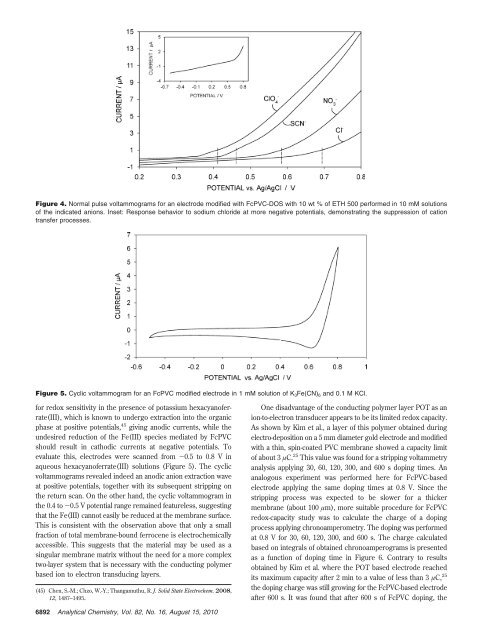Analytical Chemistry Chemical Cytometry Quantitates Superoxide
Analytical Chemistry Chemical Cytometry Quantitates Superoxide
Analytical Chemistry Chemical Cytometry Quantitates Superoxide
Create successful ePaper yourself
Turn your PDF publications into a flip-book with our unique Google optimized e-Paper software.
Figure 4. Normal pulse voltammograms for an electrode modified with FcPVC-DOS with 10 wt % of ETH 500 performed in 10 mM solutions<br />
of the indicated anions. Inset: Response behavior to sodium chloride at more negative potentials, demonstrating the suppression of cation<br />
transfer processes.<br />
Figure 5. Cyclic voltammogram for an FcPVC modified electrode in 1 mM solution of K3Fe(CN)6 and 0.1 M KCl.<br />
for redox sensitivity in the presence of potassium hexacyanoferrate(III),<br />
which is known to undergo extraction into the organic<br />
phase at positive potentials, 45 giving anodic currents, while the<br />
undesired reduction of the Fe(III) species mediated by FcPVC<br />
should result in cathodic currents at negative potentials. To<br />
evaluate this, electrodes were scanned from -0.5 to 0.8 V in<br />
aqueous hexacyanoferrate(III) solutions (Figure 5). The cyclic<br />
voltammograms revealed indeed an anodic anion extraction wave<br />
at positive potentials, together with its subsequent stripping on<br />
the return scan. On the other hand, the cyclic voltammogram in<br />
the 0.4 to -0.5 V potential range remained featureless, suggesting<br />
that the Fe(III) cannot easily be reduced at the membrane surface.<br />
This is consistent with the observation above that only a small<br />
fraction of total membrane-bound ferrocene is electrochemically<br />
accessible. This suggests that the material may be used as a<br />
singular membrane matrix without the need for a more complex<br />
two-layer system that is necessary with the conducting polymer<br />
based ion to electron transducing layers.<br />
(45) Chen, S.-M.; Chzo, W.-Y.; Thangamuthu, R. J. Solid State Electrochem. 2008,<br />
12, 1487–1495.<br />
6892 <strong>Analytical</strong> <strong>Chemistry</strong>, Vol. 82, No. 16, August 15, 2010<br />
One disadvantage of the conducting polymer layer POT as an<br />
ion-to-electron transducer appears to be its limited redox capacity.<br />
As shown by Kim et al., a layer of this polymer obtained during<br />
electro-deposition on a 5 mm diameter gold electrode and modified<br />
with a thin, spin-coated PVC membrane showed a capacity limit<br />
of about 3 µC. 25 This value was found for a stripping voltammetry<br />
analysis applying 30, 60, 120, 300, and 600 s doping times. An<br />
analogous experiment was performed here for FcPVC-based<br />
electrode applying the same doping times at 0.8 V. Since the<br />
stripping process was expected to be slower for a thicker<br />
membrane (about 100 µm), more suitable procedure for FcPVC<br />
redox-capacity study was to calculate the charge of a doping<br />
process applying chronoamperometry. The doping was performed<br />
at 0.8 V for 30, 60, 120, 300, and 600 s. The charge calculated<br />
based on integrals of obtained chronoamperograms is presented<br />
as a function of doping time in Figure 6. Contrary to results<br />
obtained by Kim et al. where the POT based electrode reached<br />
its maximum capacity after 2 min to a value of less than 3 µC, 25<br />
the doping charge was still growing for the FcPVC-based electrode<br />
after 600 s. It was found that after 600 s of FcPVC doping, the

















